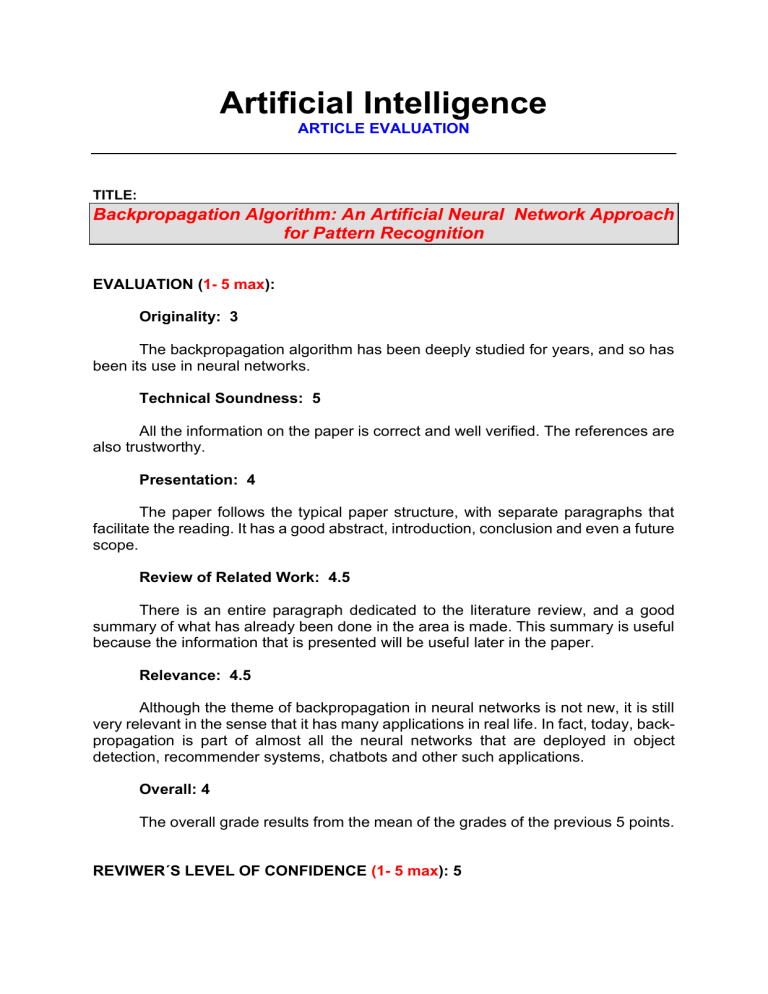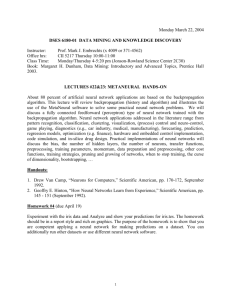
Artificial Intelligence ARTICLE EVALUATION TITLE: Backpropagation Algorithm: An Artificial Neural Network Approach for Pattern Recognition EVALUATION (1- 5 max): Originality: 3 The backpropagation algorithm has been deeply studied for years, and so has been its use in neural networks. Technical Soundness: 5 All the information on the paper is correct and well verified. The references are also trustworthy. Presentation: 4 The paper follows the typical paper structure, with separate paragraphs that facilitate the reading. It has a good abstract, introduction, conclusion and even a future scope. Review of Related Work: 4.5 There is an entire paragraph dedicated to the literature review, and a good summary of what has already been done in the area is made. This summary is useful because the information that is presented will be useful later in the paper. Relevance: 4.5 Although the theme of backpropagation in neural networks is not new, it is still very relevant in the sense that it has many applications in real life. In fact, today, backpropagation is part of almost all the neural networks that are deployed in object detection, recommender systems, chatbots and other such applications. Overall: 4 The overall grade results from the mean of the grades of the previous 5 points. REVIWER´S LEVEL OF CONFIDENCE (1- 5 max): 5 MAIN AREA: Backpropagation algorithm in neural network PAPER CATEGORY (Short / Full paper): Short RECOMMENDATION (Accept / Reject): Accept SHORT SUMMARY (max 1500 chars): This paper talks about how a neural network approach can be used for pattern recognition. The authors start out by defining what is a software design pattern and what areas use pattern recognition and for which purpose. Then, they enumerate the different approaches used for pattern recognition and proceed to explain in greater detail the neural network approach, saying that this approach is based on the concept of artificial neurons and their interconnections used to determine the data patterns through the evaluation of input-output relationships. After that, the authors list some of the algorithms that are defined under this approach and tell us why this technique is better that the others, which is mostly because of its efficiency, adaptive learning, and better tolerance to fault. Then, in the part 2 of the paper in which is made the literature review, a quote to other researchers is made to say that Artificial Neural Networks forms the most used method to perform pattern recognition tasks. In addition to that, some more algorithms used to train neural networks are presented. Moving on to part 3, this is where the authors deepen the topic of neural networks, making the distinction between supervised and unsupervised learning, and reinforcement learning. In short, what is said is that a neural net is said to learn supervised if the desired output is already known, and neural networks that learn unsupervised have no such target outputs. As for the reinforcement learning, the behaviour of the network is predicted using feedback from the background environment. The fourth and fifth parts focus more on the performance of the system, and how the neural network model chosen affects that performance. In particular, if we use a supervised model, because the network has already been trained with the required output, the system will be more accurate. One example of a widely used algorithm defined under the supervised model is the back propagation algorithm, which is explained in greater detail in part 5. DRAWBACKS (max 1000 chars): Regarding the paper drawbacks, I would point out the fact that the authors mention the advantages of the back propagation algorithm (like the fact that it is simple to use and well suited to provide a solution to all the complex patterns), but they do not mention any of the disadvantages that this algorithm poses. It is said that the algorithm is faster and more efficient depending upon the amount of input-output data available in the layers, but it is not referred in a clear way that the performance of the algorithm is highly reliant on the input data, and with low quality input data the performance will be very bad. Furthermore, it is not said that there are two types of backpropagation networks (static backpropagation and recurrent backpropagation), and no differentiation is made between these two types. Lastly, although the authors briefly mention on the conclusion that the neural network methodology is used in various real life applications like data mining, web security and medical diagnosis, and even taking into consideration that this is not the main goal of the paper, it would have been good if the authors brought more detail to the real world applications of this methodology, so that the readers could have a better understanding of where and how this is being applied. REVIEWER IDENTIFICATION (your name): Manuel Marreiros



